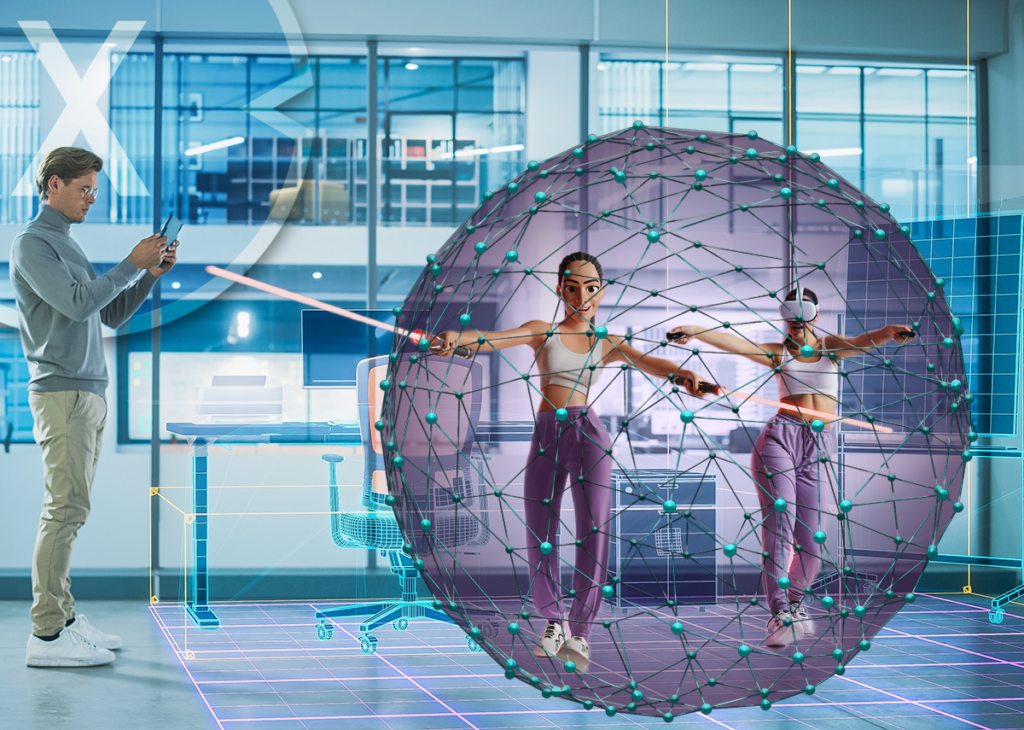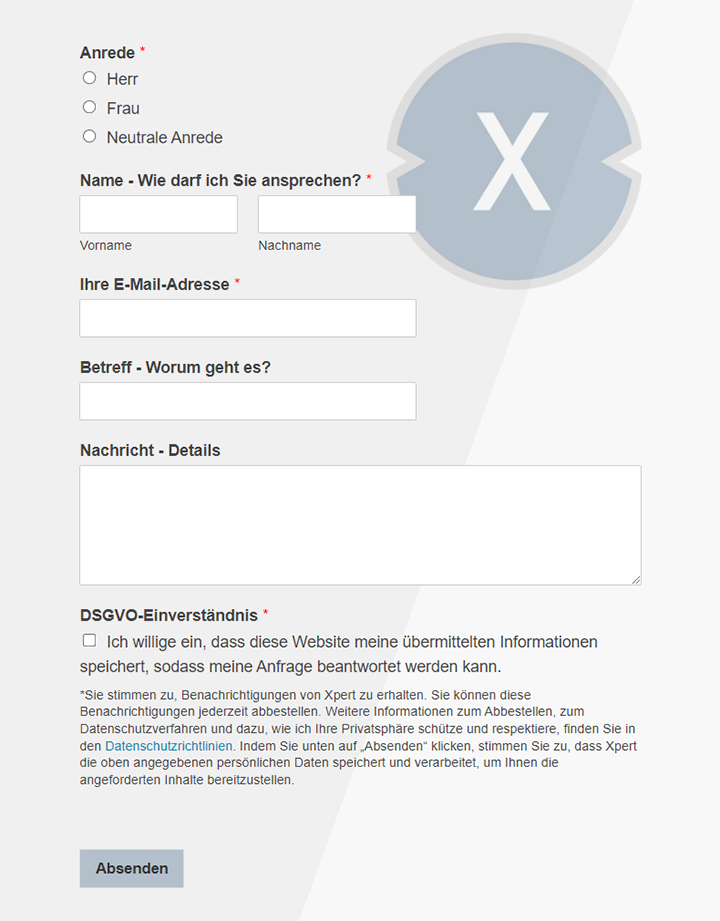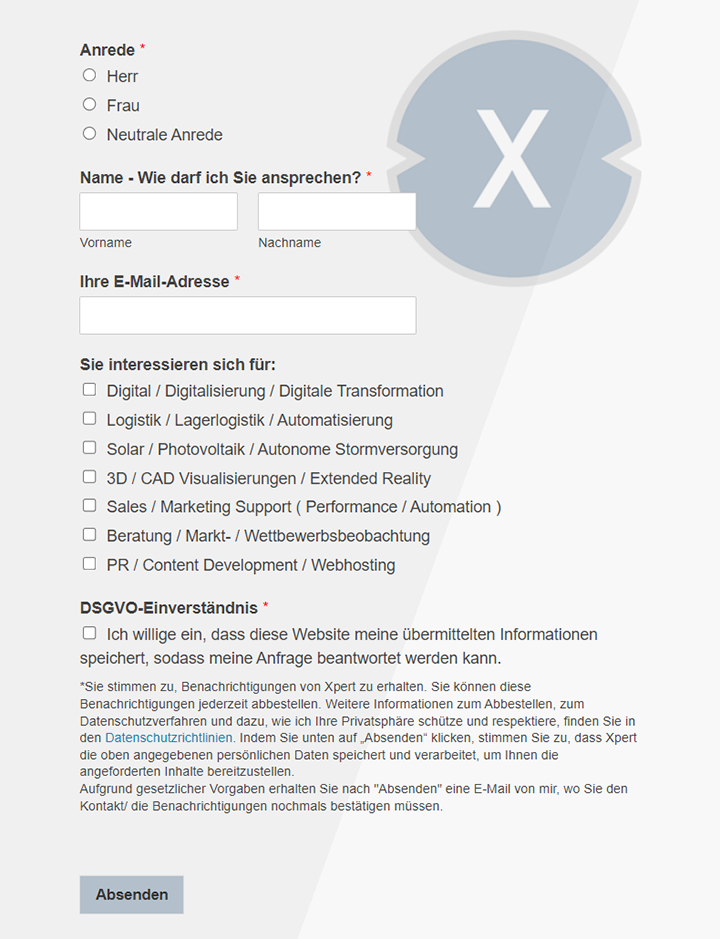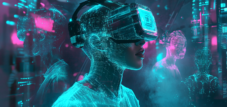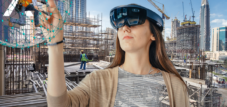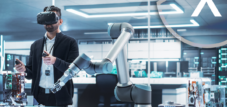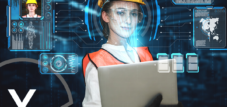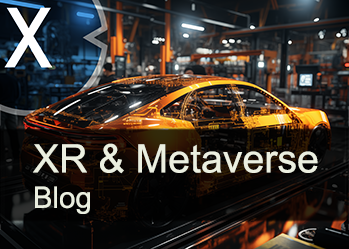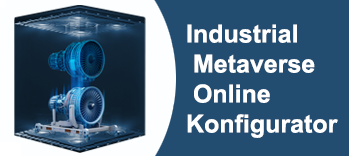The Industrial Metaverse: A global inventory of the next digital revolution
Xpert pre-release
Language selection 📢
Published on: August 23, 2025 / Updated on: August 23, 2025 – Author: Konrad Wolfenstein
Digital Twins & AI: How Siemens and Renault are already saving millions in virtual factories
### Productivity +20%, CO2 -50%: These incredible figures are already being shown by the Industrial Metaverse today ### More than just a buzzword: 7 features that make the Industrial Metaverse the next big thing ### The factory in the computer: How the Industrial Metaverse works, the biggest bet from NVIDIA and Microsoft ### After Industry 4.0 comes this: Why the Industrial Metaverse is creating the most sought-after jobs of the future ###
One to one: How the real world gets a perfect digital copy – and what that means for all of us
Industrial digitalization is on the cusp of its next transformative phase. Following the fourth industrial revolution, known as Industry 4.0, which focused on the networking of machines and the collection of data, a new stage is now emerging: the Industrial Metaverse (IMV). This concept goes far beyond previous approaches and postulates the complete merging of the physical and virtual worlds into a single, persistent, and interactive ecosystem. This is not a single, isolated technology, but rather the profound convergence of a multitude of established and new technologies, which, when combined, create an emergent capability that is greater than the sum of its parts.
In contrast to the often speculative and entertainment-oriented visions of the Consumer Metaverse, which creates virtual worlds for social interaction, gaming, and commerce, the Industrial Metaverse is firmly rooted in reality. Its primary goal is to solve concrete, real-world problems and create tangible economic and societal benefits. It is a tool being developed to better understand, control, and optimize complex industrial systems – from individual machines to entire factories to global supply chains – The driving force behind its development is not fiction, but the business imperative to increase efficiency, accelerate innovation, and operate more sustainably.
This report provides a comprehensive global assessment of the current state of development of the Industrial Metaverse. It begins with a thorough definition and delineation to create a clear understanding of the concept. It then analyzes the technological building blocks that enable this new paradigm. A detailed examination of the global market, investment trends, and the strategies of leading technology companies sheds light on the economic dynamics. Using concrete use cases and case studies from key industries, it highlights the potential already realized and measurable successes. The report quantifies the diverse benefits, from productivity increases to contributions to sustainability, while not glossing over the significant challenges that must be overcome on the path to widespread implementation. Finally, it offers a look into the future, in which generative artificial intelligence, in particular, will act as a catalyst for the next stage of development of the Industrial Metaverse.
Fundamentals of the Industrial Metaverse: Definition and Demarcation
To fully grasp the transformative potential of the Industrial Metaverse, a precise definition and clear distinction from related concepts are essential. The Industrial Metaverse is more than just a technological buzzword; it represents a fundamental shift in the way industry interacts with the digital world.
A comprehensive definition
At its core, the Industrial Metaverse describes an immersive, virtual space used for industrial applications to revolutionize research and development, production, logistics, and supply chain management. It is a virtual world that acts as a mirror image of real machines, factories, buildings, cities, and transportation systems – an "always on" universe permanently connected to physical reality.
A structured definition can be developed based on the seven characteristics formulated by the Fraunhofer Group for the metaverse in general and particularly applicable to the IMV:
- Combination of virtual and augmented real worlds: The IMV does not consist of isolated systems, but is a network of virtual worlds that are interconnected and connected to physical reality.
- Social media: It is a space where people, represented by avatars, can interact, communicate, and cooperate to work together on real-world problems.
- Persistent and long-lasting: The IMV exists continuously and regardless of whether an individual user is active.
- Integrative system: It bundles and uses a variety of technologies, including augmented reality (XR), artificial intelligence (AI), the Internet of Things (IoT), and blockchain, with open standards and interoperability being crucial.
- Capturing the real environment: A core function is the continuous capture of real-world conditions and data to keep the virtual models up-to-date and accurate.
- Multimodal participation: Users can participate in IMV in different ways and with varying intensity, whether via a desktop computer, a tablet, or fully immersed with VR glasses.
- Close integration with the real world: This is the key feature. Information, actions, and interactions are exchanged bidirectionally between the virtual and real environments and influence each other.
In addition, the IMV can be understood as a "networked, holistic digital twin of a complex system." This perspective emphasizes its function as a tool that allows decision-makers not only to understand the past but also to predict the future through simulations, thus enabling more informed strategic decisions. The fundamental paradigm shift lies in the shift from pure data analysis, as was characteristic of Industry 4.0, to data-driven interaction in real time. Value is no longer created solely by the subsequent evaluation of data, but rather by the ability to interact directly with the system in a physically accurate simulation and to immediately experience the consequences of decisions.
The crucial differences
Clearly distinguishing the Industrial Metaverse from other forms of the Metaverse is crucial for understanding its unique value creation.
The Consumer & E-Commerce Metaverse primarily targets end consumers. The focus here is on social interaction, entertainment, gaming, and the creation of virtual shopping experiences. Value creation is based on the sale of digital goods, such as avatar clothing or virtual real estate, and the provision of immersive experiences. These worlds are often purely virtual and self-contained.
The Enterprise Metaverse focuses on internal collaboration within companies. A prominent example is Accenture's "Nth Floor" platform, which is used for new employee onboarding and virtual meetings. Its goal is to improve office work, communication, and corporate culture in a virtual environment.
The Industrial Metaverse differs fundamentally from both in its purpose and its data basis. It is not primarily centered on people, but on physical assets and products (“asset/product-centric”). The data that feeds the IMV comes directly from real machines, processes, and systems. The overarching goal is the optimization of the physical world – increasing efficiency, productivity, quality, and sustainability in real production and the value chain. Its defining characteristic is the constant, bidirectional connection to physical reality. A change simulated and validated in the digital twin is implemented in the real factory; data from the real factory flows back in real time and updates the twin. It is not a means of escapism, but a powerful tool for mastering physical reality.
The development of Industry 4.0
The Industrial Metaverse is not a sudden revolution, but rather the logical and consistent evolution of the principles of Industry 4.0. Industry 4.0 laid the foundation with the introduction of cyber-physical systems, i.e., the networking of machines and systems via the Internet of Things, and created the basis for data spaces such as Catena-X or Manufacturing-X, enabling cross-company data exchange.
IMV builds on this foundation and expands it in two crucial dimensions. First, it integrates people into the data space in a new, intuitive way. While Industry 4.0 often viewed people as operators or observers of dashboards, IMV enables direct, spatial interaction with the data and digital representations of machines through immersive interfaces such as VR and AR. Second, IMV expands the focus from the optimization of individual components to the optimization of the entire system. While the digital twin in Industry 4.0 often represented a single machine or a production line, IMV aims at the "whole-system digital twin." This encompasses the entire value chain, including upstream and downstream processes, suppliers, customers, and even external environmental influences. This broadening of horizons elevates digital simulation from a purely operational to a strategic decision-making level and enables the modeling and control of the complex interactions of an entire industrial ecosystem.
Technological Convergence: Building Blocks of the Industrial Metaverse
The Industrial Metaverse is not emerging from a single groundbreaking invention, but from the synergistic convergence of a range of powerful technologies. Many of these technologies have existed for years, but it is their deep and seamless integration that creates the emergent capability that characterizes the Industrial Metaverse: the ability to mirror, simulate, and control complex real-world systems in a virtual environment in real time.
The digital twin as the heart
The heart and fundamental foundation of the Industrial Metaverse is the Digital Twin. It is far more than just a static 3D model. A modern digital twin is a dynamic, physics-based simulation model that behaves exactly like its real-world counterpart and reacts in real time to data and changing conditions. Development is progressing from simple digital replicas to highly complex, photorealistic, and physically accurate simulations. Partnerships between industry leaders such as Siemens and NVIDIA are driving this development forward, with the goal of creating interactive twins that not only look like their real-world counterparts but also behave physically identically in every respect. These highly accurate twins serve as a persistent virtual environment for simulations, live interactions, and as an interface between the real and digital worlds.
Artificial intelligence and machine learning
If the digital twin is the heart, then artificial intelligence (AI) is the engine that powers the industrial metaverse. AI and machine learning (ML) are essential for processing the massive amounts of data generated by IoT sensors in the real world and transforming it into valuable insights. AI algorithms analyze these data streams, recognize patterns, and identify anomalies, enabling applications such as forward-looking maintenance, which predicts a machine's maintenance needs before a costly failure occurs. AI-based simulations support engineers in the design and optimization of new products by rapidly testing thousands of design variants. Generative AI plays a particularly transformative role. It enables entirely new forms of interaction with digital twins, for example, through natural language, as demonstrated by the Siemens Industrial CoPilot in collaboration with Microsoft. Furthermore, generative AI can accelerate the design process itself by generating optimized designs based on predefined parameters such as weight, stability, and material consumption.
Immersive technologies (XR)
Extended Reality (XR) – the collective term for Virtual Reality (VR), Augmented Reality (AR), and Mixed Reality (MR) – forms the crucial interface between humans and the industrial metaverse. These technologies make the complex data and simulations of the IMV tangible and intuitive for humans.
Virtual Reality (VR)
creates fully immersive, computer-generated environments. In an industrial context, VR is used for realistic training scenarios in which employees can practice complex or dangerous tasks in a safe virtual environment without blocking real machines or putting themselves at risk.
Augmented Reality (AR)
overlays the real world with digital information. A technician wearing AR glasses can, for example, have maintenance instructions, circuit diagrams, or real-time sensor data projected directly onto the machine they are currently working on, in their field of vision. This enables hands-free work and significantly reduces error rates.
The foundation of connectivity
For the bidirectional connection between the real and virtual worlds to function smoothly, a robust foundation of connectivity technologies is required.
The Internet of Things (IoT) forms the sensory layer of the digital twin. Countless sensors on machines, products, and in the logistics chain continuously collect physical data such as temperature, pressure, vibration, or position. Actuators, in turn, convert digital commands into physical actions. These IoT devices provide the constant data stream that keeps the digital twin "alive" and up-to-date.
High-performance networks such as the 5G mobile communications standard, and in the future, 6G, are the nerve pathways of the IMV. They ensure fast, reliable, and above all, low-latency data transmission between IoT devices, edge and cloud servers, and users' XR devices. Only with extremely low latency are immersive real-time interactions possible.
Cloud and edge computing provide the immense computing power required for complex simulations, AI models, and rendering virtual worlds. While the cloud can store vast amounts of data and process it for global analytics, edge computing enables data processing directly on-site at the machine, which is crucial for time-critical applications with minimal latency.
Security and trust through software-defined automation
The true value of the Industrial Metaverse only unfolds when the insights and optimizations gained in the virtual world can be quickly and reliably fed back into the real world. This is where software-defined automation comes into play, acting as a crucial bridge between digital simulation and physical execution. A key element here is virtual programmable logic controllers (PLCs). Traditionally, PLCs are the "brains" of factories – physical boxes that control individual machines or processes. Their virtualization allows them to be centrally managed and updated via software updates. A process optimization validated in the digital twin can thus be rolled out to the entire real factory with just a few clicks.
In this interconnected system, cybersecurity and trust are fundamental. Protecting critical industrial data and processes from unauthorized access is a basic requirement. Technologies such as blockchain and distributed ledger technologies (DLT) can play an important role here by enabling tamper-proof, transparent, and traceable transactions, for example, for documenting supply chains or securing intellectual property.
🗒️ Xpert.Digital: A pioneer in the field of extended and augmented reality
🗒️ Find the right meta -verse agency and planning office like consulting firm – search and wanted top ten tips for advice & planning
More about it here:
81% of companies are ready: The rise of the Industrial Metaverse
Global Market Overview and Economic Dynamics
The Industrial Metaverse has evolved from a visionary concept into a dynamic and rapidly growing global market. Increasing investment and high adoption rates in key industries signal a profound shift toward immersive, data-driven manufacturing and business models. This economic momentum is fueled by clear strategic drivers and a rapidly evolving technology landscape.
Market size and growth forecasts
The assessment of the global market for the industrial metaverse reveals remarkable momentum and extraordinary growth potential. Various analysts offer different, yet consistently optimistic, assessments. The market size for 2024 is estimated at between USD 23.79 billion and USD 54.53 billion.
The forecasts for the future are even more impressive and underscore the expected transformative power of IMV. Predictions for the period up to the early 2030s vary, but all point to exponential growth. Some analyses forecast a market of USD 100 billion by 2030, while others predict USD 183.70 billion by 2032 or even USD 228.6 billion by 2029. The projected compound annual growth rates (CAGR) consistently range from approximately 30% to over 50%. These figures make it clear that IMV is not viewed as a niche technology, but as one of the key growth markets of the coming decade.
Regional developments and adoption rates
The adoption of industrial metaverse technologies is a global phenomenon, but with significant regional differences in the speed and depth of implementation. A comprehensive global survey conducted by S&P Global and Siemens in 2024 shows that 81% of surveyed companies worldwide are already actively engaging with the industrial metaverse, whether through implementation, testing, or planning.
North America, especially the US, plays a leading role. Over 38% of companies there are already actively using IMV technologies, while another 40% are in the testing phase. This pioneering role is due not only to a high level of technological affinity, but above all to the strong presence of leading platform providers that develop and provide the fundamental "operating systems" of IMV. This has led to North America dominating the global market in 2024 with a share of 33.21%.
Asia, particularly China, follows closely behind North America with a similarly high level of commitment to adopting and testing IMV solutions. The Asia-Pacific region is expected to experience the highest growth rate, driven by government incentive programs in countries such as South Korea, China, and India.
Europe, led by Germany, is also positioning itself as a key player. Around two-thirds of industrial companies in Germany are already using or testing ICT solutions. Germany's strength lies in its deep industrial base and its pioneering role in Industry 4.0, which creates a solid foundation for the implementation of ICT use cases. Other regions such as Canada, Australia, the United Kingdom, and India are also making steady progress.
Investment trends
The strategic importance of the Industrial Metaverse is reflected in the increasing investments. The survey by S&P and Siemens shows a significant increase in spending: 62% of companies worldwide have increased their investments in IMC technologies in 2024.
A notable trend is the driving role of SMEs. At 68%, SMEs are increasing their investments at an above-average rate. This indicates that the underlying technologies, particularly through cloud and "as-a-service" models, are becoming increasingly accessible and affordable and are no longer reserved exclusively for large corporations.
At the same time, large corporations are making massive financial commitments. The proportion of companies investing more than USD 10 million annually in IMV has doubled to 30% compared to the previous year. These robust investments demonstrate that IMV has moved beyond the experimental phase and is viewed as a core strategic element for future competitiveness.
Strategic drivers for adoption
The motivation for these significant investments is complex, but can be traced back to three key strategic drivers:
- Growth potential (55%): The most important driver is the expectation of opening up new revenue streams, developing innovative business models and expanding market reach.
- Facilitating innovation (47%): Almost half of companies are investing to accelerate their innovation processes. Technologies such as digital twins and AI enable them to drastically shorten product development cycles and test solutions faster than the competition.
- Improving customer support (43%): Companies use IMV to optimize service processes and improve customer interaction, for example through remote support or virtual product demonstrations.
Furthermore, sustainability is increasingly establishing itself as a decisive factor. The ability to virtually simulate production processes and entire supply chains enables companies to optimize resource consumption, reduce waste, and specifically lower their carbon footprint, bringing both ecological and economic benefits.
Strategies of the Technology Leaders: The Architects of the Industrial Metaverse
The development of the Industrial Metaverse is being driven primarily by a handful of global technology corporations. These companies are creating the fundamental platforms, tools, and ecosystems that enable industrial companies to implement their own IMC solutions. Their strategies are not monolithic, but complementary, focusing on different layers of the overall technological fabric. Instead of a "platform war," a "platform convergence" is emerging, characterized by strategic partnerships and the pursuit of interoperability.
Siemens: The ecosystem approach with Siemens Xcelerator
Siemens positions itself as a central integrator, combining its deep domain expertise from the real world of automation and industry with the digital world. Siemens' strategy is based on Siemens Xcelerator, an open digital business platform. This platform functions not as a closed system but as a curated marketplace that combines Siemens' comprehensive portfolio with the solutions of certified partners. The strategic focus is clearly on openness, creating strong ecosystems, and enabling interoperability.
A central component of this strategy is the groundbreaking partnership with NVIDIA. By linking Siemens Xcelerator with the NVIDIA Omniverse platform, the goal is to create photorealistic, physically based, and real-time interacting digital twins that combine the best of both worlds: Siemens' precise engineering data and NVIDIA's powerful visualization and simulation engine. Siemens has defined four strategic imperatives to pave the way to IMV: interoperability, standardization, data integration, and ecosystem building.
NVIDIA: The Omniverse platform as a simulation engine
NVIDIA, originally known for its graphics processing units (GPUs), has established itself as the provider of the fundamental computing and simulation infrastructure for the IMV. At the heart of this strategy is the NVIDIA Omniverse platform, a development and collaboration environment for creating 3D applications. Omniverse is based on the Universal Scene Description (USD) open standard developed by Pixar, facilitating interoperability between different 3D tools and applications.
The platform enables the creation of physically accurate, real-time rendered digital twins of the highest visual quality. NVIDIA's core competency lies in the combination of high-performance computing, advanced AI expertise, and the ability to create photorealistic visualizations. Omniverse is described as the "operating system for building and operating physically realistic digital twins" and is increasingly being delivered via cloud services (Omniverse Cloud) to facilitate access. NVIDIA pursues an open approach, integrating its platform with the software of numerous industry partners, including Siemens, Dassault Systèmes, and Autodesk.
Microsoft: Integrating Cloud, Edge, and Immersive Experiences
Microsoft's strategy for the Industrial Metaverse builds on the foundation of its established Azure cloud ecosystem. The approach aims to meet customers where they are in their digital transformation journey and enable them to embark on a phased journey. A central pillar is the creation of a common data foundation through the seamless integration of information technology (IT) and operational technology (OT) data. This is achieved through a range of Azure services such as Azure IoT, Azure Synapse Analytics, and Azure Digital Twins.
With Azure Arc, management and control are extended from the cloud to the edge, directly to the machine. The human interface to the IMV is created through immersive experiences. Here, Microsoft relies on its HoloLens 2, one of the leading mixed-reality headsets, as well as Microsoft Mesh, a platform that enables collaborative, immersive meetings directly within Microsoft Teams. The strategy is clearly focused on integration into existing corporate processes and leveraging the scalability of the global cloud infrastructure.
Dassault Systèmes: The 3DEXPERIENCE platform and the “Virtual Twin Experience”
Dassault Systèmes (DS) leverages its decades-long leadership in Product Lifecycle Management (PLM) and 3D design (CAD) software. The 3DEXPERIENCE platform is at the core of its strategy and is positioned as a holistic business and innovation platform that serves as a "single source of the truth" for all product-related data and processes.
DS is deliberately differentiating its offering by transitioning from the "Digital Twin" to the more powerful "Virtual Twin Experience." This approach not only emphasizes the digital representation but also incorporates science-based modeling and simulation, enabling a closed feedback loop between the virtual and real worlds. DS's long-term vision is "3D UNIV+RSES," designed as a "virtual-plus-real" representation of entire ecosystems. These are intended not only to serve as simulations but also to function as highly complex training environments for AI systems, while protecting customers' intellectual property.
From competition to synergy: new strategies of technology companies
This comparative analysis shows that the technology leaders are pursuing complementary strategies that focus on different, yet equally necessary, layers of the ICT ecosystem. This specialization promotes intensive collaboration and drives the development of an interoperable, high-performance overall ecosystem, rather than remaining stuck in isolated, competing silos.
Dassault Systèmes is a leader in digital transformation and product development with its innovative 3DEXPERIENCE platform. Unlike other technology companies such as Siemens, NVIDIA, and Microsoft, Dassault Systèmes pursues a holistic approach based on a "Virtual Twin Experience."
The platform focuses on Product Lifecycle Management (PLM), 3D modeling, and science-based simulation. Unlike Siemens' open digital business platform or NVIDIA's rendering and simulation engine, Dassault Systèmes positions itself as a single source of truth for enterprises.
Strategic partnerships with NVIDIA and other industry and software partners enable the company to continuously expand its technology solutions. With a focus on application and domain levels such as design, product development, and simulation, Dassault Systèmes is a key player in the digital transformation landscape.
Use cases and transformation in key industries
The true significance of the Industrial Metaverse is revealed not in theory, but in practical application. In numerous key industries, IMV technologies are already being used to solve real-world problems, transform processes, and create measurable value. Analysis of concrete case studies demonstrates how shifting from physical to virtual iteration loops leads to fundamental improvements in cost, speed, and quality.
Manufacturing industry: The smart factory of the future
In the manufacturing industry, virtual reality (IMV) perhaps reveals its most comprehensive potential. It enables the virtual planning, simulation, and commissioning of entire factories long before the first physical foundation stone is laid. This allows material flows to be optimized, bottlenecks to be identified, and errors to be avoided, leading to significant time and cost savings. During operation, production processes are continuously monitored and optimized using digital twins fed with real-time data. Applications such as remote maintenance by experts who virtually connect to a machine or immersive training for employees in VR environments are becoming the new standard.
Case study: Siemens' “Digital Native Factory” in Nanjing
An outstanding example of the implementation of this vision is Siemens' "Digital Native Factory" in Nanjing, China. This factory was digitally planned from the ground up and implemented as a holistic "digital enterprise." At the heart of the project was a comprehensive digital twin that encompassed not only the production facilities, but also the building structure and all logistical processes. The entire factory layout was simulated and optimized in this virtual environment. Employees were able to walk through their future workplaces using VR headsets and provide valuable feedback for the final design. The results of this digital approach are impressive: Production capacity increased by 200% and productivity by 20%. At the same time, space requirements were reduced by 40% while maintaining the same output, eliminating the need to invest in a complete second production line. Furthermore, optimization in the digital space led to significant savings in energy and water consumption, significantly improving the site's sustainability.
Automotive industry: From virtual planning to agile production
The automotive industry, characterized by high complexity and rapid innovation cycles, is another pioneer in the adoption of virtual reality. Use cases span the entire value chain, from collaborative vehicle development and virtual prototyping to crash test simulation, detailed production line planning, and global supply chain optimization. Companies like BMW are already using NVIDIA's Omniverse platform for virtual factory planning.
Case Study: The Renault Group
The Renault Group says it has implemented the automotive industry's first comprehensive industrial metaverse to accelerate its digital transformation. In this system, 100% of its production lines are connected, and all supply chain data is hosted in the metaverse and processed in real time. Digital twins of the factories and the entire supply chain enable continuous monitoring and control. A "control tower" consolidates all relevant information and allows for real-time response to disruptions. The projected economic impact by 2025 is significant: Renault expects savings of €320 million from process optimizations, a further €260 million from reduced inventory levels, a 60% reduction in vehicle delivery times, and a 50% reduction in the carbon footprint in manufacturing.
Aerospace and Defense: Managing Complexity and Security
In the aerospace industry, where products consist of millions of individual parts and the highest safety standards apply, the IMV offers decisive advantages. It enables the collaborative development of highly complex systems, the simulation of the interaction of all components, the training of pilots and astronauts in realistic VR environments, and the support of maintenance personnel with AR instructions.
Case Study: Airbus
Airbus uses mixed reality technologies, particularly the Microsoft HoloLens 2, in a wide range of applications. In manufacturing, digital work instructions and 3D diagrams are projected directly onto real components. This has reduced production time for certain processes by a third while simultaneously improving quality. In the complex conversion of A330 aircraft at the Getafe site, 70% of work orders are already being carried out using mixed reality. In the design process, engineers can virtually validate their designs in an immersive environment, reducing the time required for this step by 80%. These examples demonstrate how mixed reality helps manage the immense complexity of the industry while increasing efficiency and safety.
Energy and utility companies: Simulation for sustainability and resilience
For the energy industry, the IMV is a key tool for managing the energy transition and ensuring a resilient supply. It enables the creation of digital twins of complex infrastructures such as power grids, power plants, or entire urban supply systems. In these virtual environments, operators can monitor energy consumption in real time, uncover inefficiencies, and simulate various scenarios – for example, the impacts of extreme weather events or the integration of a large number of renewable energy sources into the grid. This enables better planning, increased grid stability, and targeted optimization toward a more sustainable and resilient energy supply.
Healthcare: Precision, Personalization and Innovation
The IMV also opens up new horizons in healthcare, particularly at the interface of medical technology, diagnostics, and therapy. It enables the development, prototyping, and evaluation of AI-based medical technology in a virtual environment before expensive physical devices are built. Surgeons can plan and practice highly complex procedures in detail using patient-specific digital twins created from CT or MRI scans.
Case study: Use of 3D printing and digital twins in surgery
A concrete use case that illustrates the principles of IMV in healthcare is the combination of digital patient models with 3D printing. A patient's image data is used to create a precise digital twin of the relevant anatomy. This 3D model then serves as a template for 3D printing patient-specific implants, surgical guides, or detailed anatomical models for surgical planning. For example, the SJD Barcelona Children's Hospital used a highly detailed 3D-printed model of a tumor and surrounding structures to develop a minimally invasive surgical strategy that would not have been possible without the model and led to a significantly better outcome for the young patient. This process – from the digital patient data to the virtual twin to the physical, 3D-printed object that makes a decisive difference in the real world – embodies the core idea of the Industrial Metaverse.
🎯🎯🎯 Benefit from Xpert.Digital's extensive, fivefold expertise in a comprehensive service package | R&D, XR, PR & SEM
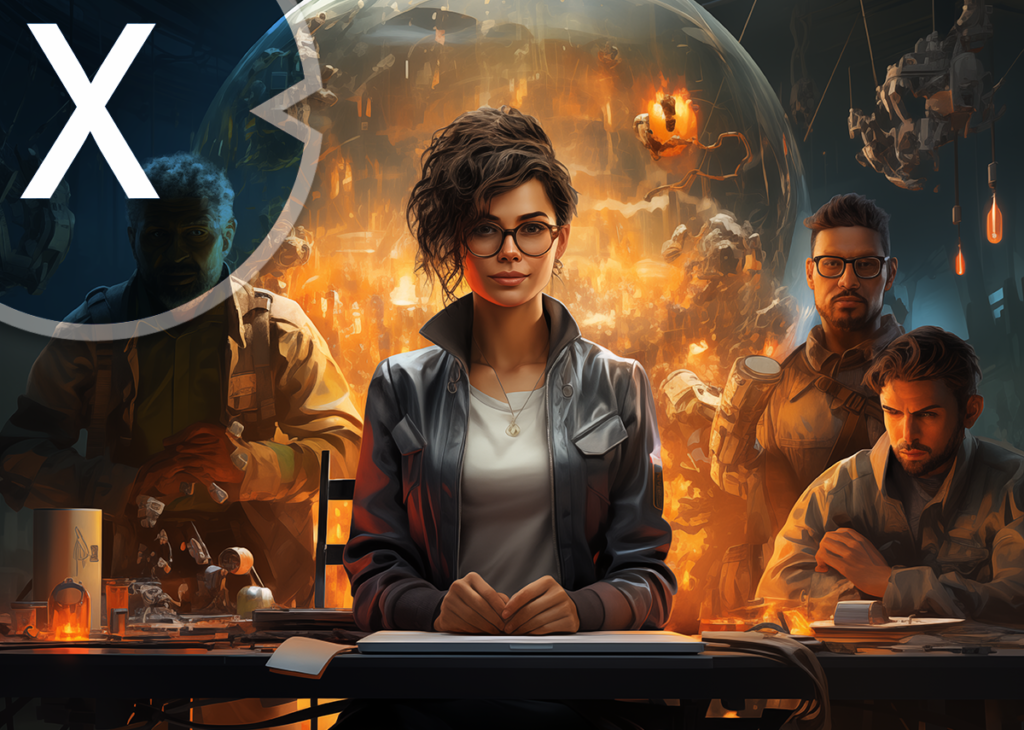
AI & XR-3D-Rendering Machine: five times expertise from Xpert.digital in a comprehensive service package, R&D XR, Pr & SEM – Image: Xpert.digital
Xpert.Digital has in-depth knowledge of various industries. This allows us to develop tailor-made strategies that are tailored precisely to the requirements and challenges of your specific market segment. By continually analyzing market trends and following industry developments, we can act with foresight and offer innovative solutions. Through the combination of experience and knowledge, we generate added value and give our customers a decisive competitive advantage.
More about it here:
AI and Simulation: How Companies Double Their Efficiency
Quantifiable benefits and added value
The implementation of the Industrial Metaverse is not an end in itself, but is driven by the promise of significant and measurable economic benefits. These benefits are not isolated but form a system of mutually reinforcing effects that permeate the entire value chain and lead to a fundamental increase in competitiveness.
Increase productivity and efficiency
The potential for significant efficiency improvements and productivity gains is one of the main drivers for the adoption of IMV. Through virtual simulation and optimization of production processes, improved resource utilization, and the minimization of unplanned downtime through forward-looking maintenance, companies can significantly increase their Overall Equipment Effectiveness (OEE). Productivity gains are often in the double-digit percentage range. Siemens' "Digital Native Factory" in Nanjing, for example, achieved a 20% productivity increase. These gains result from a combination of optimized processes, more qualified employees through better training, and data-driven, real-time decision-making.
Sustainable cost reduction and resource optimization
The Industrial Metaverse offers significant opportunities for sustainable cost reduction in various business areas. A key lever is the drastic reduction in the need for expensive physical prototypes in product development, as these are replaced by virtual prototypes. Travel costs are also significantly reduced through remote collaboration, virtual commissioning, and remote maintenance. Early error detection in the simulation phase avoids costly scrap and rework in real production. The Renault Group case study illustrates the extent of this potential, with planned savings of €320 million from process optimization alone. These cost reductions are often directly linked to better resource optimization, which improves both economic efficiency and environmental responsibility.
Accelerating innovation and time to market
The ability to test new ideas, products, and production concepts quickly and cost-effectively in a virtual environment is a decisive competitive advantage. Virtualization enables the parallelization of product and production development, significantly shortening traditionally sequential and lengthy processes. Companies can respond more quickly to market changes and bring innovations to market more quickly. The case of Siemens Numerical Control, where time to market was reduced by an impressive 200%, demonstrates the transformative potential in this area.
Improving global cooperation
In a globalized economy, the Industrial Metaverse transcends physical distances and time zones. Globally distributed teams of engineers, designers, production planners, and even suppliers can work on the same digital twins in a shared, persistent virtual space, as if they were sitting in the same room. This not only improves collaboration efficiency but also promotes knowledge transfer, breaks down departmental silos, and leads to more holistic and better decisions.
Sustainability as a key advantage
Beyond the direct economic benefits, IMV is becoming a crucial tool for achieving sustainable development (ESG) goals. Through detailed simulation of energy and material flows, companies can precisely analyze and optimize their resource consumption, waste, and emissions. Virtual product development reduces material consumption for prototypes, and reduced travel through remote collaboration directly contributes to reducing the carbon footprint. The Renault Group has set itself the ambitious goal of reducing the carbon footprint of its vehicle production by 50% using IMV. IMV thus makes it possible to reconcile economics and ecological considerations and realize more sustainable industrial value creation.
Challenges on the way to implementation
Despite the enormous potential and the successes already visible, the path to widespread implementation of the Industrial Metaverse is fraught with considerable challenges. These hurdles are not only technological in nature, but also encompass organizational, financial, legal, and human aspects. The success of the Industrial Metaverse will depend significantly on how companies and society succeed in solving these complex, socio-technical issues.
Technical hurdles
The biggest technical challenge, cited by 47% of companies, is the lack of interoperability and standardization. IMV arises from the convergence of technologies, platforms, and data formats from different vendors. Without common, open standards, seamless integration of these components is virtually impossible. Proprietary, isolated solutions prevent the creation of a connected ecosystem and significantly limit the potential of IMV. Initiatives such as the Metaverse Standards Forum and the Alliance for Open Universal Scene Description (OpenUSD) are working on developing such standards, but this process is complex and lengthy.
Closely related to this is the challenge of data integration and quality. Combining data from heterogeneous sources, especially from operational technology (OT) and information technology (IT), is a complex task. The accuracy and value of a digital twin depend directly on the quality, completeness, and timeliness of the underlying data. Ensuring a robust and reliable database is therefore a fundamental prerequisite.
Organizational and financial aspects
Implementing the Industrial Metaverse requires significant initial investments in hardware (e.g., XR devices, powerful servers), software licenses, and personnel training. These high costs can pose a significant hurdle, especially for small and medium-sized enterprises (SMEs).
Furthermore, the technical complexity of implementation should not be underestimated. It is not enough to simply purchase individual technologies; they must be integrated into existing processes and IT landscapes and aligned with overarching business objectives. This requires a clear strategy, a deep technical understanding, and often a fundamental transformation of organizational structures and workflows.
Data security, data protection and legal framework
The industrial metaverse processes vast amounts of highly sensitive corporate data, including design plans, production data, and trade secrets. Ensuring data security and cybersecurity is therefore vital to protect against industrial espionage, sabotage, and other cyberattacks.
At the same time, companies operate in a complex legal environment. Currently, there is no specific "metaverse law." Instead, existing laws from civil law, data protection law (e.g., GDPR), copyright law, and labor law must be applied to the new virtual situations, which leads to considerable legal uncertainty. Particularly for globally operating teams in a shared virtual space, the complex question of applicable national law arises, for example, with regard to working hours or co-determination.
The human factor: Skills shortage and skills development
One of the biggest obstacles to the rapid adoption of ICT is the lack of qualified specialists. 44% of companies see the skills shortage as a major challenge. There is a lack of experts with in-depth knowledge of key technologies such as AI, digital twins, IoT, and XR. This poses a serious threat to future competitiveness, particularly in industrialized nations like Germany, where the population's digital skills are below average compared to the EU.
There is an urgent need to fundamentally modernize training and continuing education systems and adapt them to new requirements. Skills in data analysis, computer science, and the application of VR/AR technologies must be taught widely. Companies must invest in the retraining and upskilling of their existing workforce and create new, attractive job profiles to attract and retain talent for the industries of the future. Without the people who can design, operate, and further develop these complex socio-technical systems, the full potential of the Industrial Metaverse will remain untapped.
The Future of the Industrial Metaverse
The Industrial Metaverse is only at the beginning of its development, but the direction is clear: It will fundamentally change the way products are designed, manufactured, and operated. Future technological breakthroughs, particularly in artificial intelligence, will further accelerate this transformation and lead to an even more interconnected, autonomous, and sustainable industrial ecosystem. It is therefore crucial for companies to set strategic course now.
The role of Generative AI as a catalyst
Generative Artificial Intelligence (GenAI) is emerging as one of the most transformative forces for the industrial metaverse. Its impact extends far beyond mere data analysis and particularly affects the interaction with and creation of virtual worlds.
GenAI will revolutionize the IMV user experience by enabling interaction through natural language. Instead of having to navigate complex software, engineers or managers can formulate their requests in simple language, such as: "Simulate the impact of a failure of machine X on the weekly output." GenAI acts as an intelligent "translator" between human intent and complex technical simulation, thus democratizing access to the IMV's powerful tools.
Furthermore, GenAI will drastically accelerate the virtual content creation process. It can create realistic 3D models from text descriptions or 2D sketches, generate complex virtual environments, or suggest optimized design alternatives for components. The combination of the physics-based precision of IMV and the data-driven creativity of GenAI promises an exponential acceleration of innovation cycles.
Long-term vision: A connected, autonomous and sustainable industrial ecosystem
The long-term vision of the Industrial Metaverse goes far beyond the optimization of individual factories. It aims at a global network of interoperable digital twins that map entire value chains and ecosystems. In such a networked system, the production capacities of different companies could be used dynamically and flexibly to respond to fluctuations in demand or make supply chains more resilient.
In this vision of the future, autonomous systems and AI agents will take over routine tasks in planning, control, and maintenance, while human workers focus on complex problem-solving, creativity, and strategic decision-making. This could lead to a kind of "digital market for industrial capacity," where AI-driven production orders are allocated to the most suitable and available resource in the network. The IMC would then no longer be merely an optimization tool, but the operating system for a "manufacturing-as-a-service" economy that achieves the highest levels of efficiency, resilience, and sustainability.
Recommendations for action for companies: Strategic imperatives
To succeed in this rapidly evolving landscape and capitalize on the opportunities presented by the Industrial Metaverse, companies must take a proactive and strategic approach. Based on the analysis of technology leaders and the challenges of implementation, four key strategic imperatives can be derived that can serve as a guide for companies:
- Promote interoperability: Companies should consistently focus on open standards and interfaces in their technology decisions and avoid proprietary, isolated solutions. The ability to seamlessly exchange data and models with partners, suppliers, and customers will be a decisive competitive factor.
- Drive standardization: Instead of simply waiting, companies should actively participate in the development of standards, for example, by participating in cross-industry bodies like the Metaverse Standards Forum. This is the only way to ensure that future standards meet their own requirements.
- Understanding data integration as a foundation: A robust, enterprise-wide data strategy is a prerequisite for any IT integration project. This includes overcoming the silos between IT and OT and creating a unified, high-quality data foundation.
- Think in ecosystems: No company can handle the complexity of IMV alone. Building strategic partnerships with technology providers, research institutions, customers, and even competitors is essential to pool knowledge, share risks, and jointly develop innovative solutions.
Companies that embrace these imperatives and view the Industrial Metaverse not as a short-term technology trend but as a long-term strategic transformation will be able to shape the next wave of industrial digitalization and sustainably secure their position in global competition.
Digital Twins and AI: The Turning Point of Industrial Innovation
The Industrial Metaverse marks a decisive turning point in the digital transformation of industry. It is no longer a distant vision of the future, but rather a pragmatic evolution already underway, building on the foundations of Industry 4.0 and significantly expanding them. An analysis of the global development status paints a clear picture: The Industrial Metaverse is developing into a central paradigm for industrial value creation in the 21st century, driven by robust investments and a high, steadily growing adoption rate in all major industrialized nations.
The core idea of the Industrial Metaverse – the complete merging of the physical and virtual worlds through a holistic, data-driven digital twin – enables a fundamental transformation. The focus shifts from pure data collection and analysis to immersive, interactive simulation and control of complex systems in real time. This leads to quantifiable and mutually reinforcing benefits: significant increases in productivity and efficiency, sustainable cost reductions, a drastic acceleration of innovation cycles, and improved global collaboration. Furthermore, the Industrial Metaverse is proving to be a crucial tool for achieving sustainability goals by enabling the optimization of resource and energy consumption.
The technological implementation is being driven by global platform leaders such as Siemens, NVIDIA, Microsoft, and Dassault Systèmes, whose complementary strategies aim to create an open, interoperable, and collaborative ecosystem. Instead of competition over closed systems, a future of networked specialization is emerging.
Nevertheless, the path to the full realization of the Industrial Metaverse is fraught with considerable challenges. Technical hurdles such as a lack of interoperability and standardization, the complexity of data integration, cybersecurity issues, and unclear legal frameworks must be overcome. Perhaps the greatest challenge, however, lies in the human factor: The acute shortage of skilled workers in the relevant digital disciplines poses a serious threat to competitiveness and requires massive efforts in training and continuing education.
Looking ahead, generative artificial intelligence will act as a crucial catalyst that will democratize interaction with the ICT and exponentially expand its capabilities. The long-term vision of a globally connected, autonomous, and sustainable industrial ecosystem is ambitious, but the technological and strategic foundations for this are being laid today.
For companies, the Industrial Metaverse is no longer an option, but a strategic necessity. Those who act proactively now, invest in open technologies and ecosystems, and build the necessary competencies will not only transform their own business models but also play a key role in shaping the future of global industry.
We are there for you – advice – planning – implementation – project management
☑️ SME support in strategy, consulting, planning and implementation
☑️ Creation or realignment of the digital strategy and digitalization
☑️ Expansion and optimization of international sales processes
☑️ Global & Digital B2B trading platforms
☑️ Pioneer Business Development
I would be happy to serve as your personal advisor.
You can contact me by filling out the contact form below or simply call me on +49 89 89 674 804 (Munich) .
I'm looking forward to our joint project.
Xpert.digital – Konrad Wolfenstein
Xpert.Digital is a hub for industry with a focus on digitalization, mechanical engineering, logistics/intralogistics and photovoltaics.
With our 360° business development solution, we support well-known companies from new business to after sales.
Market intelligence, smarketing, marketing automation, content development, PR, mail campaigns, personalized social media and lead nurturing are part of our digital tools.
You can find more at: www.xpert.digital – www.xpert.solar – www.xpert.plus




